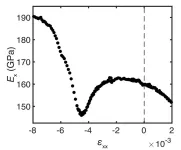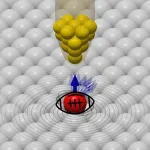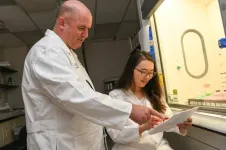(Press-News.org) New research from the University of Birmingham shows that the electronic structure of metals can strongly affect their mechanical properties.
The research, published today (26th October) in the journal Science, demonstrates experimentally, for the first time, that the electronic and mechanical properties of a metal are connected. It was previously understood theoretically that there would be a connection, but it was thought that it would be too small to detect in an experiment.
Dr Clifford Hicks, Reader in Condensed Matter Physics, who worked on the study said: “Mechanical properties are typically described in terms of the bonding between atoms, while electronic properties of metals are described by states that extend across many atoms. The atomic lattice (the term used to describe the arrangement of atoms) of a metal and its mechanical properties are generally thought of as being unaffected by which electronic states are occupied and which are empty, but in this work, we show that this is not always a good assumption.”
The researchers from the University of Birmingham and the Max Planck Institute for Chemical Physics of Solids (in Dresden, Germany) conducted experiments on the superconducting metal strontium ruthenate (Sr2RuO4). By measuring lattice distortion as a function of applied stress, the team found that when Sr2RuO4 is compressed by about 0.5%, a measure of mechanical stiffness known as the Young's modulus decreases by about 10%, and then increases by about 20% when the material is compressed further. This change corresponds to a new set of electronic states becoming occupied, at a transition that had been identified earlier through electronic but not mechanical measurements.
Dr Hicks continued: “Whilst it is completely standard to measure stress-strain relationships in mechanical engineering, it is not something that has been done to study electronic properties. This is because the metals that have interesting electronic properties tend to be brittle, making it hard to apply large forces. Also, large strains are typically required to meaningfully alter electronic properties. In this experiment, samples of Sr2RuO4 were compressed by up to 1%. To visualise that, imagine taking a metrestick made of granite, and squeezing it until it is 99 cm long.”
To overcome these hurdles, the scientists had to build new instrumentation which could measure small and delicate samples, and handle cryogenic temperatures, as electronic measurements are more accurate at lower temperatures. This took five years of planning and design.
This research, which was funded by the German Research Foundation (Deutsche Forschungsgemeinschaft) and the Max Planck Society, is the first of its kind.
Now that this experiment has been completed on one material, the scientists are keen to conduct similar measurements on other metals. A version of the machine developed for this project is manufactured by a U.K.-based engineering company, and as the apparatus is further developed it may find application in the study of high-strength alloys. This project provides an example of how curiosity-driven, fundamental research can lead to new technology with practical applications.
ENDS
For more information please contact Ellie Hail, Communications Officer, University of Birmingham at e.hail@bham.ac.uk or alternatively on +44 (0)7966 311 409. You can also contact the Press Office out of hours on +44 (0)121 414 2772.
Notes to editors
More information, including a copy of the paper, can be found online at the Science press package at https://www.eurekalert.org/press/scipak/.
The University of Birmingham is ranked amongst the world’s top 100 institutions. Its work brings people from across the world to Birmingham, including researchers, teachers and more than 8,000 international students from over 150 countries. END
Semiconductors—most notably, silicon—underpin the computers, cellphones, and other electronic devices that power our daily lives, including the device on which you are reading this article. As ubiquitous as semiconductors have become, they come with limitations. The atomic structure of any material vibrates, which creates quantum particles called phonons. Phonons in turn cause the particles—either electrons or electron-hole pairs called excitons—that carry energy and information around electronic devices to scatter in a matter of nanometers and femtoseconds. This means that energy is lost in the form of heat, and that information transfer has ...
To date, research has suggested that only humans and some species of toothed whales live many years of active life after the loss of reproductive ability. But now, a new study shows female chimpanzees in Uganda show signs of menopause – surviving long past the end of their ability to reproduce. Signs of menopause in wild chimpanzees may provide insights into the evolution of this rare trait in humans. The vast majority of mammals stay fertile until the very ends of their lives, with humans and several species of toothed whales as the outliers; they experience menopause. In humans, menopause ...
For the first time in human history, say Daniel Gervais and John Nay in a Policy Forum, nonhuman entities that are not directed by humans – such as artificial intelligence (AI)-operated corporations – should enter the legal system as a new “species” of legal subject. AI has evolved to the point where it could function as a legal subject with rights and obligations, say the authors. As such, before the issue becomes too complex and difficult to disentangle, “interspecific” legal frameworks need to be developed by which AI can be treated as legal subjects, they write. Until now, the legal system has been univocal ...
While small, the hypothalamus – a complex structure located deep in the brain – plays a gargantuan role in coordinating the wide array of neuronal signals that are responsible for keeping the body in a stable state. In a Special Issue of Science, authors across four Reviews unpack this key brain region’s impact on physiological and behavioral homeostasis.
The hypothalamus consists of a complex collection of neural circuits. These circuits receive, process, and integrate sensory inputs to drive coordinated communication via a range of behavioral, ...
In a Perspective, Stephen Tang and Samuel Sternberg discuss retroelement-based gene editing as a safer alternative to CRISPR-Cas approaches. Precision genome editing technologies have transformed modern biology. Capabilities for programable DNA targeting have improved rapidly, largely due to the development of bacterial RNA-guided CRISPR-Cas systems, which allow precise cleavage of target DNA sequences. However, CRISPR-Cas9 systems generate a DNA double strand break (DSB), which activates cellular DNA repair pathways that can lead to unwanted and complex byproducts, ...
Key takeaways
Female chimpanzees in Uganda’s Ngogo community experienced a menopausal transition similar to women.
Fertility among chimpanzees studied declined after age 30, and no births were observed after age 50.
The data can help researchers better understand why menopause and post-fertile survival occur in nature and how it evolved in the human species.
A team of researchers studying the Ngogo community of wild chimpanzees in western Uganda’s Kibale National Park for two decades has published a report in Science showing that females in this population can ...
The hardness of materials is determined by the strength of the chemical bonds that are formed between the electrons of the neighbouring atoms. For example, the bonds in diamond are very strong, so it is one of the hardest materials known. The bonding is rooted in the laws of quantum mechanics, and the complex compounds that are of most interest in forefront research today are known as ‘quantum materials.’ In many quantum materials, layers of strongly bonded atoms separate layers in ...
Extreme conditions prevail in the Würzburg laboratory of experimental physicists Professor Matthias Bode and Dr. Artem Odobesko. Affiliated with the Cluster of Excellence ct.qmat, a collaboration between JMU Würzburg and TU Dresden, these visionaries are setting new milestones in quantum research. Their latest endeavor is unveiling the spinaron effect. They strategically placed individual cobalt atoms onto a copper surface, brought the temperature down to 1.4 Kelvin (–271.75° Celsius), and then subjected them to a powerful external magnetic field. “The magnet we use costs half a million euros. It’s not something that’s widely available,” explains ...
University of Alberta researchers have identified an amino acid that may play a key role in predicting poor clinical outcomes and the treatment of long COVID.
In research published today in Cell Reports Medicine, the team says it has developed a predictive test to determine which patients with COVID-19 will go on to develop longer-term symptoms and proposes a clinical trial of an already-approved supplement as a potential treatment.
“This research helps us understand what’s happening in the bodies of people ...
A four-year, $3.4 million grant to investigate molecular mechanisms and therapeutic treatments for acute respiratory distress syndrome (ARDS) has been awarded to UTHealth Houston researchers by the National Heart, Lung, and Blood Institute, part of the National Institutes of Health.
The study led by principal investigators Holger Eltzschig, MD, PhD, professor and chair of the Department of Anesthesiology, Critical Care and Pain Medicine at McGovern Medical School at UTHealth Houston, and Xiaoyi Yuan, PhD, assistant professor in the department, is built on many years of research in the endogenous ...



